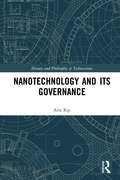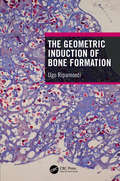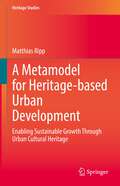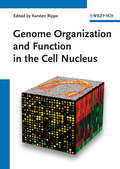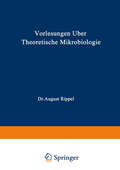- Table View
- List View
Nanotechnology and Its Governance (History and Philosophy of Technoscience)
by Arie RipThis book charts the development of nanotechnology in relation to society from the early years of the twenty-first century. It offers a sustained analysis of the life of nanotechnology, from the laboratory to society, from scientific promises to societal governance, and attempts to modulate developments.
The Geometric Induction of Bone Formation
by Ugo RipamontiThe Geometric Induction of Bone Formation describes new biomimetic biomaterials that offer mechanistic osteogenic surfaces for the autonomous and spontaneous induction of bone formation without the addition of osteogenic soluble molecular signals of the transforming growth factor-β supergene family. The chapters frame our understanding of regenerative medicine in primate species, including humans. The goal is to unravel the fundamental biological mechanisms of bone formation unique to non-human and human primates. The broad target audience dovetails with several disciplines both in the academic and private biotech sectors primarily involved in molecular biology, tissue biology, tissue engineering, biomaterial science, and reconstructive, orthopedic, plastic, and dental surgery. Key Features Includes outstanding images of undecalcified whole mounted sections Summarizes non-human primate research – ideal for clinical translation Reviews methods for creating devices capable of making bone autonomously, i.e. an intrinsically osteo-inductive bioreactor and/or biomaterial Describes the spontaneous induction of bone formation including a whole spectrum of tissue biology, from basic molecular biology to clear-cut morphology and pre-clinical application in non-human primate species Intended for audiences in both academic research and the biotech industry
The Geometric Induction of Bone Formation
by Ugo RipamontiThe Geometric Induction of Bone Formation describes new biomimetic biomaterials that offer mechanistic osteogenic surfaces for the autonomous and spontaneous induction of bone formation without the addition of osteogenic soluble molecular signals of the transforming growth factor-β supergene family. The chapters frame our understanding of regenerative medicine in primate species, including humans. The goal is to unravel the fundamental biological mechanisms of bone formation unique to non-human and human primates. The broad target audience dovetails with several disciplines both in the academic and private biotech sectors primarily involved in molecular biology, tissue biology, tissue engineering, biomaterial science, and reconstructive, orthopedic, plastic, and dental surgery. Key Features Includes outstanding images of undecalcified whole mounted sections Summarizes non-human primate research – ideal for clinical translation Reviews methods for creating devices capable of making bone autonomously, i.e. an intrinsically osteo-inductive bioreactor and/or biomaterial Describes the spontaneous induction of bone formation including a whole spectrum of tissue biology, from basic molecular biology to clear-cut morphology and pre-clinical application in non-human primate species Intended for audiences in both academic research and the biotech industry
Induction of Bone Formation in Primates: The Transforming Growth Factor-beta 3
by Ugo RipamontiThe effects of the bone morphogenetic proteins (BMPs) family on bone formation are well documented, but the transforming growth factor (TGF)-beta ( isoforms are much less studied. The product of 20 years of study, Induction of Bone Formation in Primates: The Transforming Growth Factor- sums up editor Ugo Ripamonti's research into the osteogenic a
A Metamodel for Heritage-based Urban Development: Enabling Sustainable Growth Through Urban Cultural Heritage (Heritage Studies)
by Matthias RippThis book proposes a Metamodel for heritage-based urban development, based on urban morphology, governance theory, and the metamodeling concept of John P. Van Gigch. Building on international policies such as the 2011 Recommendation for Historic Urban Landscapes and the results of the 2016 Urban Habitat III Conference, cultural heritage is now regarded as a potential resource for sustainable urban development. While more and more evidence of the potential benefits of cultural heritage for sustainable development has been published, this book is the first to develop and design a Metamodel that can be universally applied in a wide variety of settings. The Metamodel was developed using grounded theory and design research methodology and is based on three successful case-models from European contexts. The book includes three application scenarios that elaborate how the metamodel can be used to design, evaluate, and improve processes where cultural heritage is a starting point for sustainable urban development.
Bioluminescent Imaging: Methods and Protocols (Methods in Molecular Biology #2081)
by Steven RippThis volume provides detailed protocols and methodologies required to perform bioluminescent imaging in multiple stages, enabling the reader to integrate this technology into their laboratory-based imaging experiments. Written in the highly successful Methods in Molecular Biology series format, chapters include introductions to their respective topics, lists of the necessary materials and reagents, step-by-step, readily reproducible laboratory protocols, and tips on troubleshooting and avoiding known pitfalls. Authoritative and cutting-edge, Bioluminescent Imaging: Methods and Protocols to ensure successful results in the further study of this vital field.
Fructose, High Fructose Corn Syrup, Sucrose and Health (Nutrition and Health)
by James M. RippeThe metabolic and health effects of both nutritive and non-nutritive sweeteners are controversial, and subjects of intense scientific debate. These potential effects span not only important scientific questions, but are also of great interest to media, the public and potentially even regulatory bodies. Fructose, High Fructose Corn Syrup, Sucrose and Health serves as a critical resource for practice-oriented physicians, integrative healthcare practitioners, academicians involved in the education of graduate students and post-doctoral fellows, and medical students, interns and residents, allied health professionals and nutrition researchers, registered dietitians and public health professions who are actively involved in providing data-driven recommendations on the role of sucrose, HFCS, glucose, fructose and non-nutritive sweeteners in the health of their students, patients and clients. Comprehensive chapters discuss the effects of both nutritive and non-nutritive sweeteners on appetite and food consumption as well as the physiologic and neurologic responses to sweetness. Chapter authors are world class, practice and research oriented nutrition authorities, who provide practical, data-driven resources based upon the totality of the evidence to help the reader understand the basics of fructose, high fructose corn syrup and sucrose biochemistry and examine the consequences of acute and chronic consumption of these sweeteners in the diets of young children through to adolescence and adulthood. Fructose, High Fructose Corn Syrup, Sucrose and Health fills a much needed gap in the literature and will serve the reader as the most authoritative resource in the field to date.
Genome Organization And Function In The Cell Nucleus
by Karsten RippeBy way of its clear and logical structure, as well as abundant highresolution illustrations, this is a systematic survey of the players and pathways that control genome function in the mammalian cell nucleus. As such, this handbook and reference ties together recently gained knowledge from a variety of scientific disciplines and approaches, dissecting all major genomic events: transcription, replication, repair, recombination and chromosome segregation. A special emphasis is put on transcriptional control, including genome-wide interactions and non-coding RNAs, chromatin structure, epigenetics and nuclear organization. With its focus on fundamental mechanisms and the associated biomolecules, this will remain essential reading for years to come.
Genome Organization And Function In The Cell Nucleus
by Karsten RippeBy way of its clear and logical structure, as well as abundant highresolution illustrations, this is a systematic survey of the players and pathways that control genome function in the mammalian cell nucleus. As such, this handbook and reference ties together recently gained knowledge from a variety of scientific disciplines and approaches, dissecting all major genomic events: transcription, replication, repair, recombination and chromosome segregation. A special emphasis is put on transcriptional control, including genome-wide interactions and non-coding RNAs, chromatin structure, epigenetics and nuclear organization. With its focus on fundamental mechanisms and the associated biomolecules, this will remain essential reading for years to come.
Vorlesungen Über Boden-Mikrobiologie
by August RippelDieser Buchtitel ist Teil des Digitalisierungsprojekts Springer Book Archives mit Publikationen, die seit den Anfängen des Verlags von 1842 erschienen sind. Der Verlag stellt mit diesem Archiv Quellen für die historische wie auch die disziplingeschichtliche Forschung zur Verfügung, die jeweils im historischen Kontext betrachtet werden müssen. Dieser Titel erschien in der Zeit vor 1945 und wird daher in seiner zeittypischen politisch-ideologischen Ausrichtung vom Verlag nicht beworben.
Vorlesungen über Theoretische Mikrobiologie
by August RippelDieser Buchtitel ist Teil des Digitalisierungsprojekts Springer Book Archives mit Publikationen, die seit den Anfängen des Verlags von 1842 erschienen sind. Der Verlag stellt mit diesem Archiv Quellen für die historische wie auch die disziplingeschichtliche Forschung zur Verfügung, die jeweils im historischen Kontext betrachtet werden müssen. Dieser Titel erschien in der Zeit vor 1945 und wird daher in seiner zeittypischen politisch-ideologischen Ausrichtung vom Verlag nicht beworben.
Mikro- und Ultrafiltration mit Membranen
by Siegfried RippergerMikro- und Ultrafiltration mit Membranen Klar strukturiert und kompakt wird hier die Mikro- und Ultrafiltration mit Membranen behandelt, von den Grundlagen und Charakterisierung von Membranen bis hin zu industriellen Anwendungen und Instandhaltung Die Mikro- und Ultrafiltration mit Membranen ist eine verbreitete und etablierte Schlüsseltechnologie für die Aufbereitung von Stoffströmen. Im Buch werden sowohl die Grundlagen der Mikro- und Ultrafiltration mit Membranen, Herstellung und Charakterisierung, Filtrationsverfahren, industrielle Anwendungen als auch die Instandhaltung und Reinigung von Membranen behandelt. Prinzipien und praktische Anwendungen werden klar strukturiert dem Leser zugänglich gemacht Behandelt alle Prozesse von Grundlagen bis zu den Anwendungen Unverzichtbar für die Ausarbeitung, Etablierung und Instandhaltung von Membrantrennverfahren Es bietet eine umfassende Einführung in die Theorie und Praxis der Membranfiltration und gibt wertvolle Einblicke in die verschiedenen Anwendungen und Technologien. Ob Sie nun ein erfahrener Ingenieur sind oder gerade erst in die Welt der Membranfiltration eintauchen, dieses Buch wird Ihnen helfen, Ihre Kenntnisse zu vertiefen und Ihre Fähigkeiten zu verbessern. Mit klaren Erklärungen, anschaulichen Beispielen und praktischen Tipps ist es ein unverzichtbares Nachschlagewerk für jeden, der sich mit der Filtration von Flüssigkeiten beschäftigt.
Mikro- und Ultrafiltration mit Membranen
by Siegfried RippergerMikro- und Ultrafiltration mit Membranen Klar strukturiert und kompakt wird hier die Mikro- und Ultrafiltration mit Membranen behandelt, von den Grundlagen und Charakterisierung von Membranen bis hin zu industriellen Anwendungen und Instandhaltung Die Mikro- und Ultrafiltration mit Membranen ist eine verbreitete und etablierte Schlüsseltechnologie für die Aufbereitung von Stoffströmen. Im Buch werden sowohl die Grundlagen der Mikro- und Ultrafiltration mit Membranen, Herstellung und Charakterisierung, Filtrationsverfahren, industrielle Anwendungen als auch die Instandhaltung und Reinigung von Membranen behandelt. Prinzipien und praktische Anwendungen werden klar strukturiert dem Leser zugänglich gemacht Behandelt alle Prozesse von Grundlagen bis zu den Anwendungen Unverzichtbar für die Ausarbeitung, Etablierung und Instandhaltung von Membrantrennverfahren Es bietet eine umfassende Einführung in die Theorie und Praxis der Membranfiltration und gibt wertvolle Einblicke in die verschiedenen Anwendungen und Technologien. Ob Sie nun ein erfahrener Ingenieur sind oder gerade erst in die Welt der Membranfiltration eintauchen, dieses Buch wird Ihnen helfen, Ihre Kenntnisse zu vertiefen und Ihre Fähigkeiten zu verbessern. Mit klaren Erklärungen, anschaulichen Beispielen und praktischen Tipps ist es ein unverzichtbares Nachschlagewerk für jeden, der sich mit der Filtration von Flüssigkeiten beschäftigt.
Entwicklung und Planung verfahrenstechnischer Anlagen (VDI-Buch)
by Siegfried Ripperger Kai NikolausDieses Fachbuch vermittelt wesentliche Grundlagen für die Entwicklung und Planung verfahrenstechnischer Anlagen, bei der technische, betriebliche, wirtschaftliche und rechtliche Forderungen beachtet werden müssen. Nach einer Einführung in die Anlagentechnik und das Projektmanagement werden wirtschaftliche Aspekte betrachtet, da die notwendigen finanziellen Mittel für eine Anlage in der Regel durch den zu erwartenden wirtschaftlichen Nutzeffekt gerechtfertigt werden. Verfahrenstechnische Anlagen sind oft einzigartig. Um dennoch eine zügige Projektabwicklung zu gewährleisten und um Kosten zu senken kommt der Modularisierung eine immer größere Bedeutung zu. Daher ist diesem Trend ein eigenes Kapitel gewidmet. Nach einer kurzen Einführung in das technische Recht werden zu beachtende rechtliche Aspekte behandelt. Weitere Kapitel beschreiben die Rolle der Normung, die große Palette der verwendeten Werkstoffe sowie bekannte Regeln zur Dimensionierung und Gestaltung von Bauelementen der Apparate.
Erfolgreich als Quereinsteiger
by Stefan Rippler Branko WoischwillEine geradlinige Karriere wird in der dynamischen Arbeitswelt immer seltener. Viele Arbeitnehmer engagieren und etablieren sich in Branchen, Aufgaben und Berufen, die mit ihrer ursprünglichen Ausbildung wenig zu tun haben. Die Autoren erkunden die besonderen Stärken und Eigenschaften von Quereinsteigern und führen zahlreiche berufliche Metamorphosen zusammen. Nach einer kompakten Analyse der Arbeitsmarktsituation folgen praktische Tipps von der konstruktiven Selbstreflektion über erfolgreiche Bewerbungen und die Probezeit bis zur Bewältigung fachlicher oder sozialer Hindernisse im Berufsalltag. Die guten Chancen für Quereinsteiger werden nicht nur von Zahlen, Daten und Fakten bestätigt. Auch aufschlussreiche Interviews mit Vertretern renommierter Unternehmen, z. B. Accenture, BASF, Deutsche Bahn, IKEA oder REWE und Gespräche mit erfolgreichen Quereinsteigern bieten Einblicke in individuelle Wege zum Traumjob, inspirieren zu neuen Zielen und zeigen Wert und Sinn mancher Umwege – eine lebendige, praxisorientierte Hilfestellung für die berufliche Neuorientierung und den gelungenen Neustart.
The Gendered Brain: The new neuroscience that shatters the myth of the female brain
by Gina Rippon'A treasure trove of information and good humour' CORDELIA FINE, author of Testosterone RexDo you have a female brain or a male brain? Or is that the wrong question?Reading maps or reading emotions? Barbie or Lego? We live in a gendered world where we are bombarded with messages about sex and gender. On a daily basis we face deeply ingrained beliefs that your sex determines your skills and preferences, from toys and colours to career choice and salaries. But what does this constant gendering mean for our thoughts, decisions and behaviour? And what does it mean for our brains?Drawing on her work as a professor of cognitive neuroimaging, Gina Rippon unpacks the stereotypes that bombard us from our earliest moments and shows how these messages mould our ideas of ourselves and even shape our brains. Taking us back through centuries of sexism, The Gendered Brain reveals how science has been misinterpreted or misused to ask the wrong questions. Instead of challenging the status quo, we are still bound by outdated stereotypes and assumptions. By exploring new, cutting-edge neuroscience, Rippon urges us to move beyond a binary view of our brains and instead to see these complex organs as highly individualised, profoundly adaptable, and full of unbounded potential.Rigorous, timely and liberating, The Gendered Brain has huge repercussions for women and men, for parents and children, and for how we identify ourselves.
Chemie der Genetik (Colloquium der Gesellschaft für Biologische Chemie in Mosbach Baden #9)
by Hans Ris Günther Siebert Max Alfert Adolf Wacker Fritz Kaudewitz Wolfhard Weidel Jan WaldenströmManaging Climate Change and Sustainability through Behavioural Transformation (Sustainable Development Goals Series)
by Parul RishiThis book addresses climate change and sustainability management from a transdisciplinary perspective which encompasses within itself how different humanistic disciplines can culminate with each other to move ahead with the agenda. Issues of adapting to climate change and sustainability management have been gaining global prominence over the past few decades. There have also been volumes of literature that highlight the technical dimensions of climate change and sustainability across regions and cultures. However, they have had limited strength to bring direct and desirable impact in promoting pro-climate action and sustainability behaviour. The major reason for this is limited inclusion of pluralistic perspectives into human cognition and affect, and resultant limited public acceptability. Although behavioural science as a discipline has taken a front seat in promoting behavioural transformation, the book argues that other humanistic fields of understanding like education, art, literature, philosophy, political science, sociology, economics, etc., have to be integrated in order to present a holistic standpoint to sustainability literature.
Mathematizing Space: The Objects of Geometry from Antiquity to the Early Modern Age (Trends in the History of Science)
by Vincenzo RisiThis book collects the papers of the conference held in Berlin, Germany, 27-29 August 2012, on 'Space, Geometry and the Imagination from Antiquity to the Modern Age'. The conference was a joint effort by the Max Planck Institute for the History of Science (Berlin) and the Centro die Ricerca Matematica Ennio De Giorgi (Pisa).
Leibniz and the Structure of Sciences: Modern Perspectives on the History of Logic, Mathematics, Epistemology (Boston Studies in the Philosophy and History of Science #337)
by Vincenzo De RisiThe book offers a collection of essays on various aspects of Leibniz’s scientific thought, written by historians of science and world-leading experts on Leibniz. The essays deal with a vast array of topics on the exact sciences: Leibniz’s logic, mereology, the notion of infinity and cardinality, the foundations of geometry, the theory of curves and differential geometry, and finally dynamics and general epistemology. Several chapters attempt a reading of Leibniz’s scientific works through modern mathematical tools, and compare Leibniz’s results in these fields with 19th- and 20th-Century conceptions of them. All of them have special care in framing Leibniz’s work in historical context, and sometimes offer wider historical perspectives that go much beyond Leibniz’s researches. A special emphasis is given to effective mathematical practice rather than purely epistemological thought. The book is addressed to all scholars of the exact sciences who have an interest in historical research and Leibniz in particular, and may be useful to historians of mathematics, physics, and epistemology, mathematicians with historical interests, and philosophers of science at large.
Mechanical Design
by Antonino RisitanoDesigned as a supplement to the unparalleled and traditional engineering textbooks written by "the maestro" Prof. Giovannozzi, this review of the notes and lessons crucial to Machine Construction courses and Industrial Engineering students allows for the utmost comprehension of the subject matter at a decrease in study time, an important contributi
The Fokker-Planck Equation: Methods of Solution and Applications (Springer Series in Synergetics #18)
by Hannes Risken Till FrankThis is the first textbook to include the matrix continued-fraction method, which is very effective in dealing with simple Fokker-Planck equations having two variables. Other methods covered are the simulation method, the eigen-function expansion, numerical integration, and the variational method. Each solution is applied to the statistics of a simple laser model and to Brownian motion in potentials. The whole is rounded off with a supplement containing a short review of new material together with some recent references. This new study edition will prove to be very useful for graduate students in physics, chemical physics, and electrical engineering, as well as for research workers in these fields.
